23 Punctuation: Commas, Colons, and Semi-colons
Learning Objectives
After completing this chapter, you will be able to
- Use commas correctly
- in lists
- after introductory words or phrases
- with coordinate and subordinate conjunctions
- around parenthetical phrases
- with modifiers and adjectives
- Use semi-colons correctly to join sentences
- Use colons correctly to introduce lists, quotes and examples
Using punctuation correctly is critical to creating well-constructed sentences with clear meaning.
Commas
Commas are used to separate grammatical items in a sentence.
Watch this video[1] to understand how to use commas correctly:
Commas to separate items in a series or a list of three or more items.
When you list three or more items in a sentence, use a comma before each item in the list, including one before the word and, but, or or. Items in a list can include nouns, verbs, and even phrases:
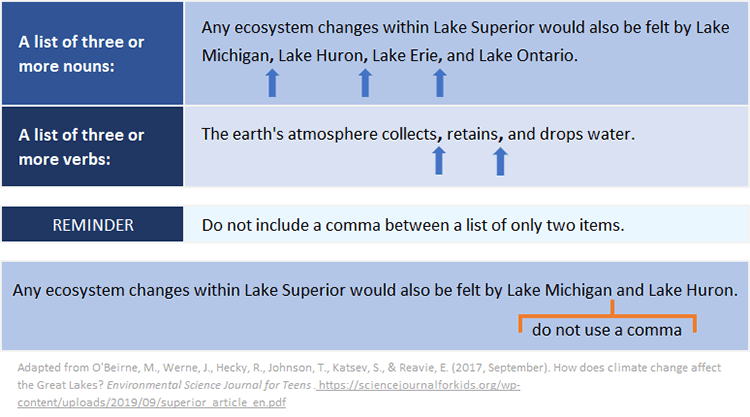
Commas with an introductory word or phrase
Sometimes a comma is used near the beginning of a sentence to let the reader know where the introductory word, phrase, or clause ends and the main idea begins. Common introductory words and phrases include the following:
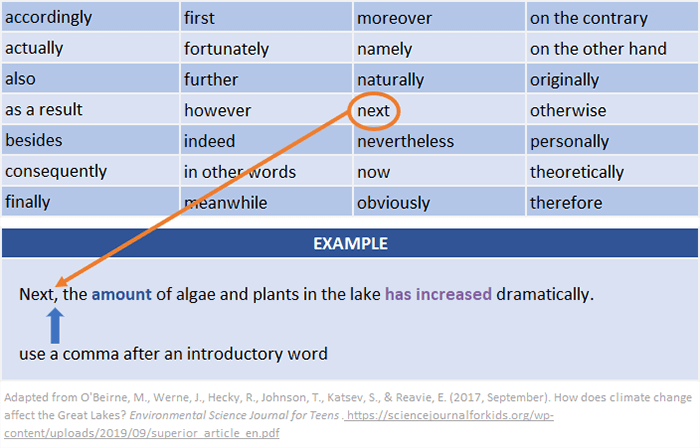
Example sentences with an introductory word or phrase:
- Therefore, the scientists had to end the study early.
- According to meteorologists, smoke from forest fires creates its own weather patterns.
Sometimes a comma is used after an introductory dependent phrase (which often starts with an -ing) or after a dependent clause (which often starts with a subordinating conjunction).
In the example below, notice that the comma separates the dependent phrase from the independent clause:

Introductory dependent clauses often begin with these common subordinating conjunctions:
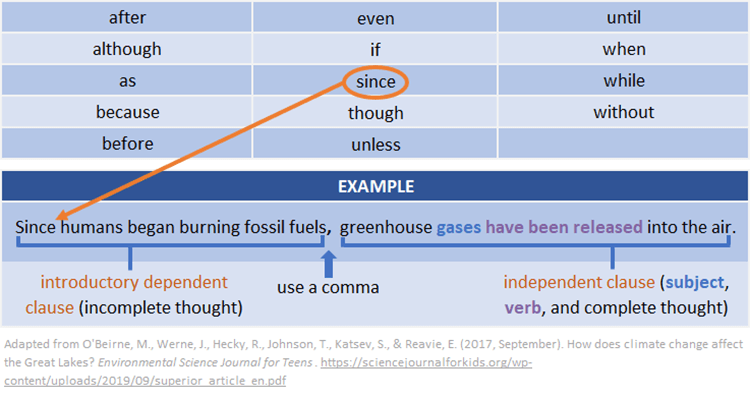
Notice in the example above that a comma is used to separate the introductory dependent clause from the independent clause. However, notice in the example below that a comma is not used; do not use a comma if the sentence ends with a dependent clause. In other words, if the subordinate conjunction is at the beginning of the sentence, you need a comma in the middle; if the subordinate conjunction is in the middle of the sentence, do not use a comma.

Commas to surround interrupters and appositives
An interrupting word or phrase interrupts the flow of a sentence. Usually, when an interrupting word or phrase is omitted, the sentence still makes sense and the meaning of the sentence does not change. In other words, an interrupting word or phrase is not essential to the sentence.
Common interrupting words include the words however and for example:
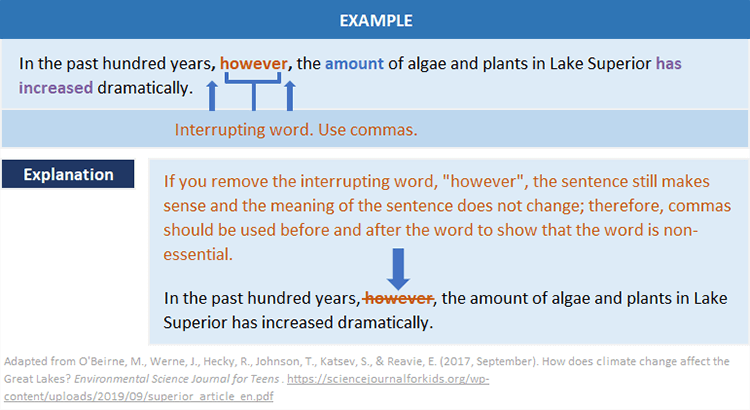
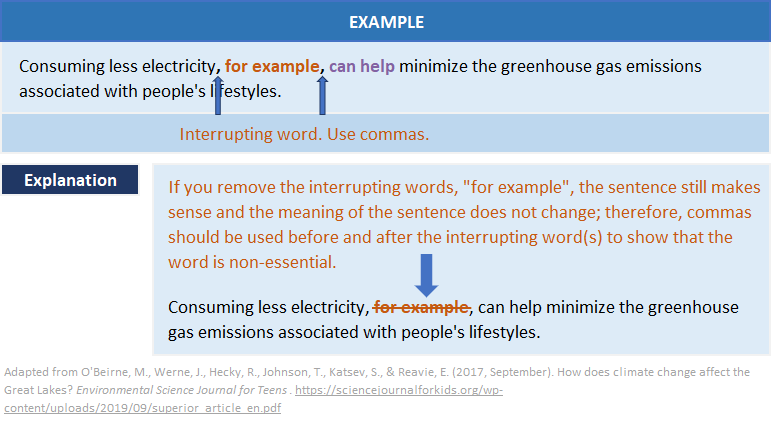
An appositive is a noun or noun phrase that describes another noun or noun phrase already mentioned in the sentence. Use commas before and after an appositive since the sentence still makes sense when the appositive is removed from the sentence and the meaning of the sentence does not change.
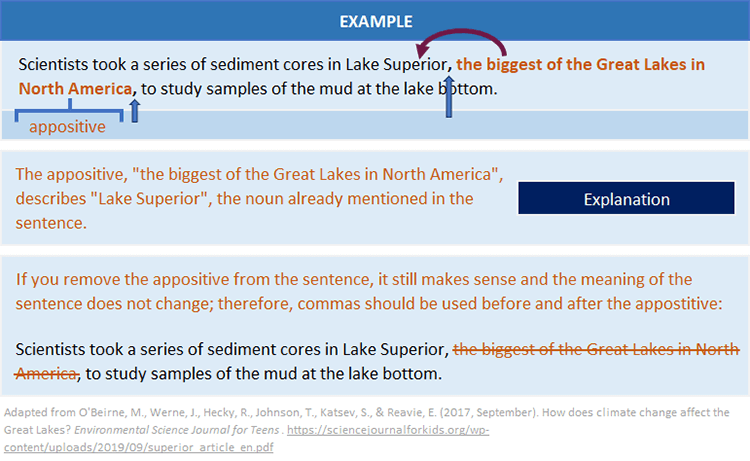
Commas with interrupting non-defining clauses
A non-defining clause adds extra, non-essential information to a sentence. You can think of a non-defining clause as a parenthetical phrase; the phrase could be removed without harming the grammar or meaning of the sentence. Here is an example of a non-defining clause (with a comma): I live near Lake Superior, which is one of the largest fresh water lakes in the world.
An interrupting phrase that starts with the word which is usually non-essential and requires commas. You can tell if a phrase is non-essential to the sentence if the meaning of the sentence does not change and still makes sense when the phrase is removed:
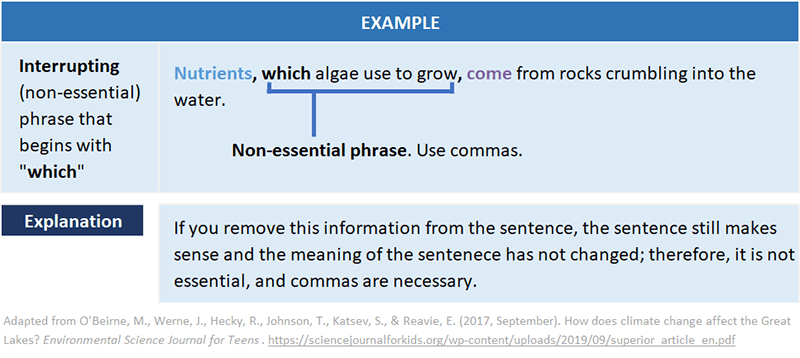
A defining clause contains information that is critical to the meaning of the sentence. Here is an example of a defining clause (without a comma): My teacher is the woman who won the award. You can tell if a phrase is essential to the sentence if the meaning of the sentence is changed or no longer makes sentence when it is removed:
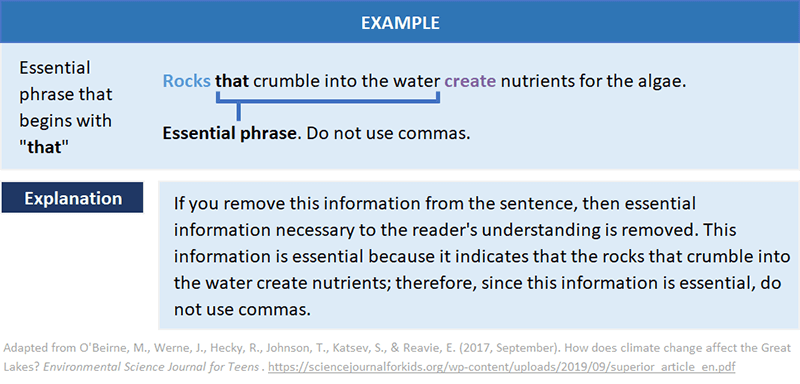
Sometimes commas are required for interrupting phrases that begin with who as well; however, a phrase that begins with who can also be essential. Be sure to check to see if the phrase can be removed from the sentence in order to determine if commas are required or not.
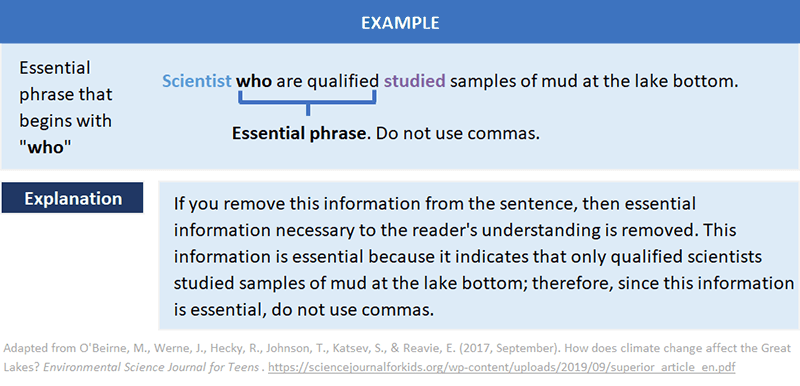
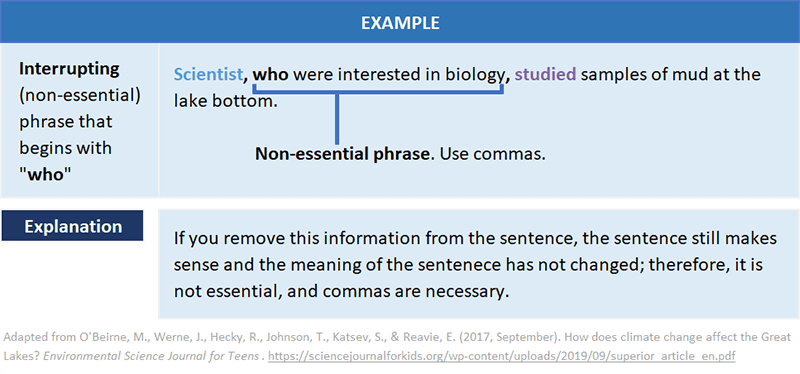
Commas with conjunctions
You must use a comma with a coordinating conjunction (FANBOYS) when the conjunction is being used to join two complete sentences.
You use a comma with a subordinating conjunction when the dependent (incomplete) clause is at the beginning of the sentence.
| Type of Conjunction | Explanation of Comma Use | Example Sentence |
| Coordinating conjunction
|
use a comma to join the two complete thoughts | I missed the final, and I didn’t complete most of the homework. |
| Coordinating conjunction
|
do NOT use a comma if the second half of the sentence is not complete on its own | I missed the final and didn’t complete most of the homework. |
| Subordinating conjunction
|
use a comma when the dependent clause is at the beginning | Because I was sick, I stayed home. |
| Subordinating conjunction
|
do NOT use a comma when the dependent clause is at the end | I stayed home because I was sick. |
Commas are used before coordinating conjunctions that join two independent clauses. The most common coordinating conjunctions form the acronym FANBOYS (For, And, Nor, But, Or, Yet, So).
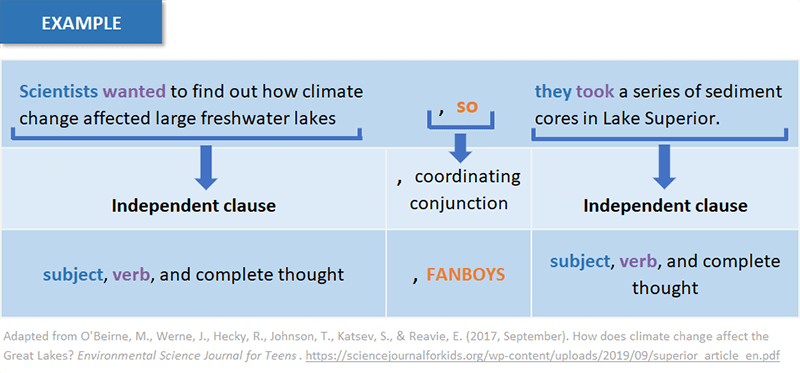
Some sentences contain the words for, and, nor, but, or, yet, so; however, these words do not require a comma before them in the sentence because an independent clause does not come before and after the word.
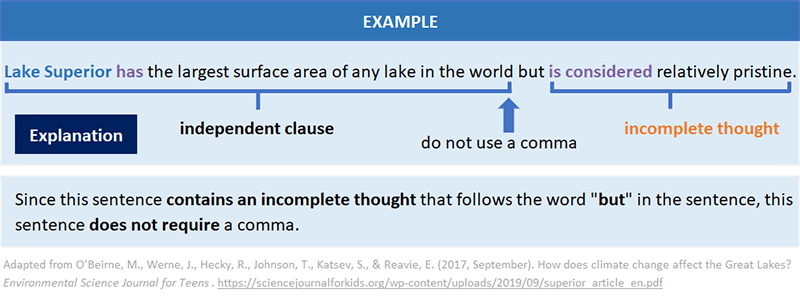
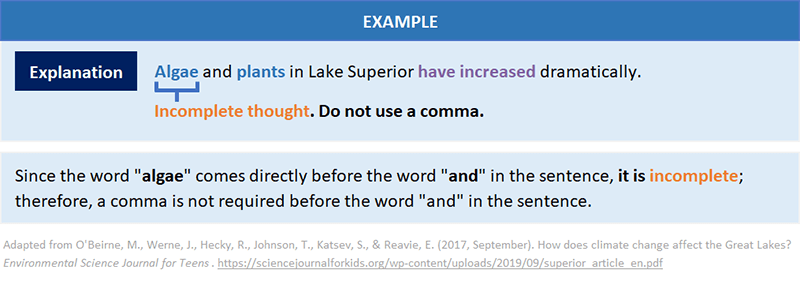
Commas with descriptive words.
Sometimes a list of descriptive words known as adjectives may appear before a noun in a sentence. You may or may not need to include a comma between a list of two or more adjectives in a sentence.
Coordinate adjectives describe the noun equally. You can put the adjectives in any order, and you could put the word “and” between them.
Cumulative adjectives build on each other and they cannot be reordered. If your have cumulative adjectives, you do not place commas between them; similarly, putting the word and between them does not work.
| Type of Adjective | Explanation of Comma Use | Example Sentence |
| Coordinate adjectives
|
use a comma to separate the adjectives when you can reorder the adjectives or put “and” between them | Maria carried the wet, muddy puppy into the house.
Maria carried the muddy, wet puppy… Maria carried the muddy and wet puppy… |
| Cumulative adjectives
|
do NOT use a comma to separate the adjectives if you cannot reorder the adjectives or put “and” between them. | I know those four red-headed girls.
NOT: I know those red-headed four girls. |
There are two questions you must ask in order to determine if a comma is necessary between two or more adjectives:
- Does the sentence make sense if you place the word “and” between the adjectives?
- Does the sentence make sense if you reverse the order of the adjectives?
If the answer is YES to both of these questions, then a comma IS needed.
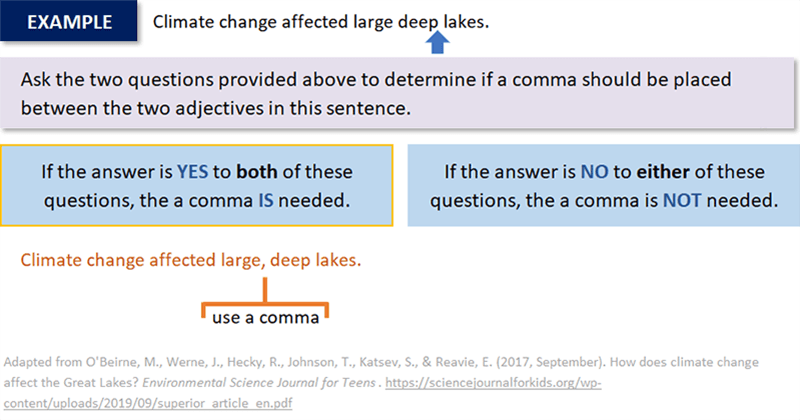
If the answer is NO to either of these questions, then a comma IS NOT needed.
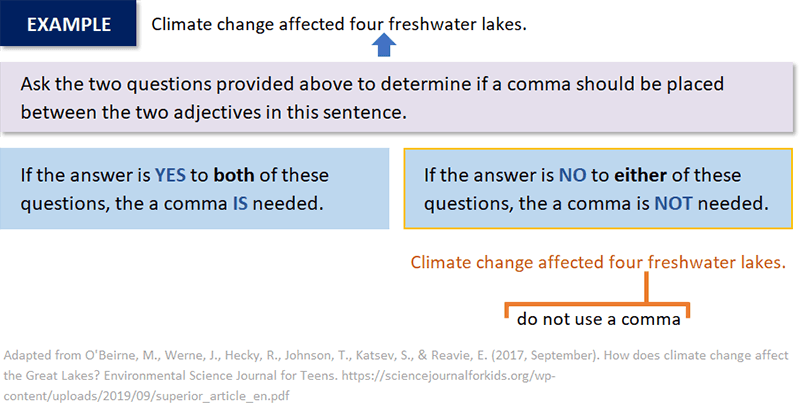
Commas to separate elements in addresses and dates
Use commas to separate elements in dates:
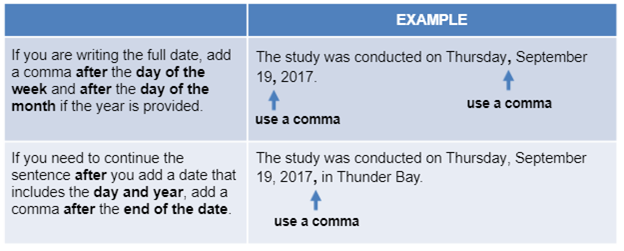
Do not use commas in any of the following situations:
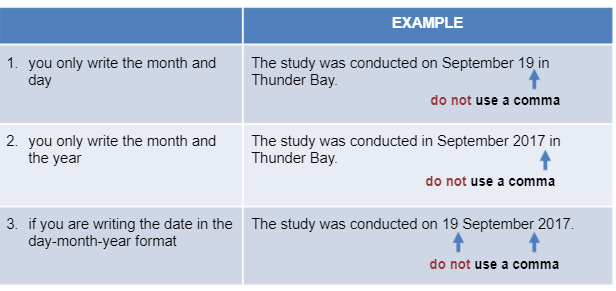
Use commas to separate items in addresses:
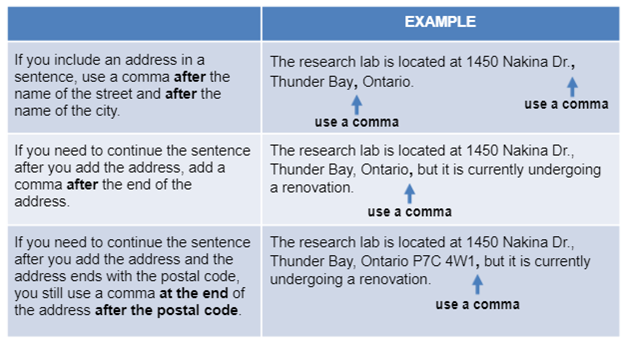
Do not use a comma between the province and the postal code:

Watch this video[2] to practice comma use:
Colons
Colons (:) are used to introduce some addition information following a complete sentence. The information provided after a colon can be used to introduce different types of information.
1. Introduce a list
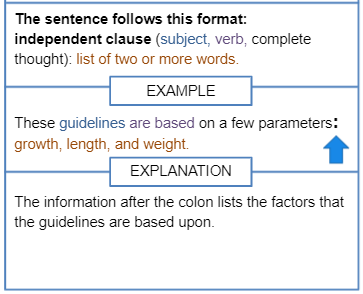
2. Introduce a term
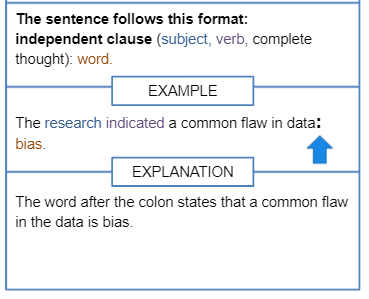
3. Introduce a clause
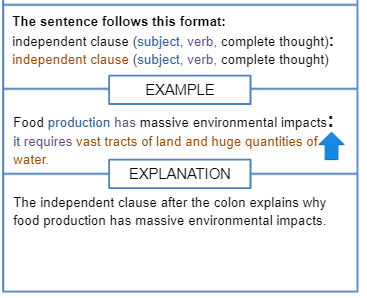
4. Introduce a phrase
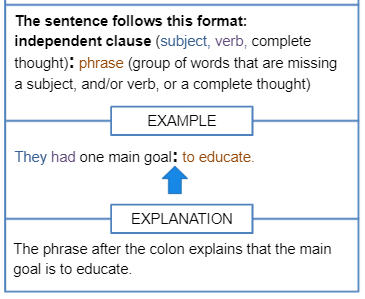
Tip: Do not use a colon if an independent clause does not appear before the list, word, phrase, or another independent clause.
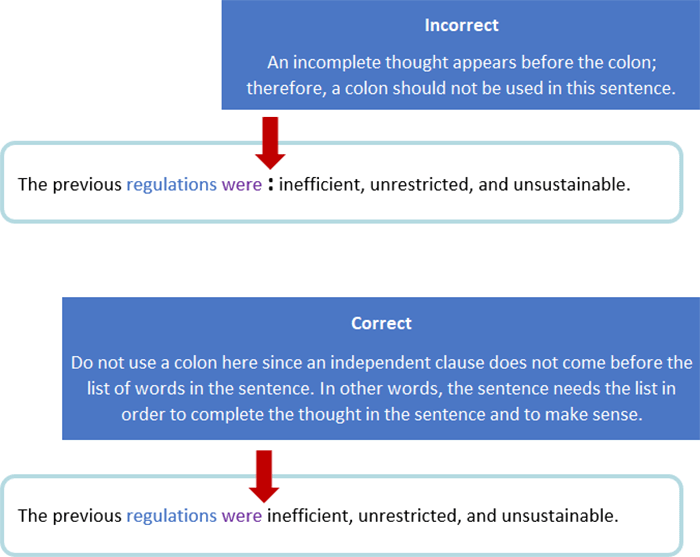
Semicolons
Semi-colons (;) can be used to connect two related independent clauses to make a complex sentence. A semicolon is a mark to signal a partial separation of things. Unlike a period, which signals a “stop”, a semicolon says “yield” or flow into the next thought.
Semicolons have two uses:
1. To replace a period between two closely related sentences.
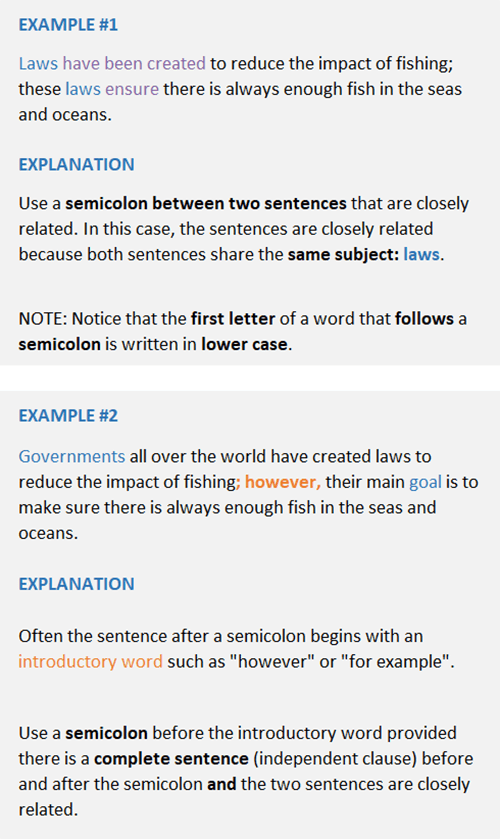
2. To separate items in a list when commas are already used.
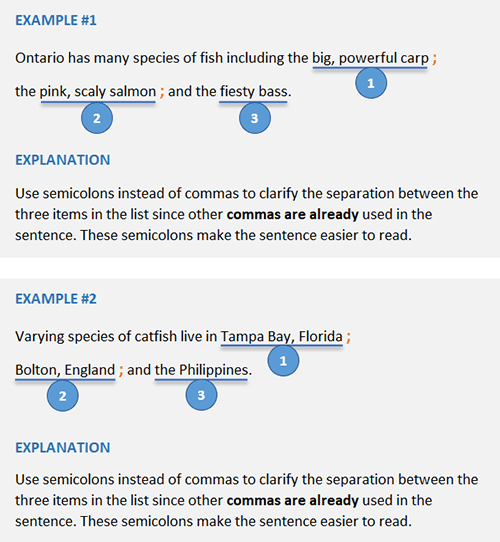
Tip: Do not use a semicolon between two sentences that are not closely related. Use a period instead.
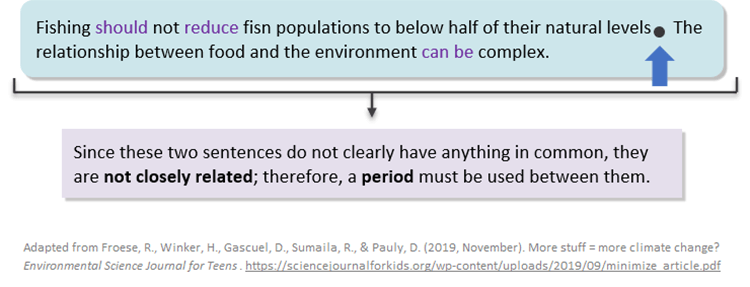
Watch this video[3] to understand how to use these punctuation marks:
Additional Resources
- Shannon, D. (2021, March 28). Commas 1 [Video]. YouTube. https://youtu.be/wLjyfbqRyiU. ↵
- Shannon, D. (2021, March 28). Commas 2 (video). YouTube. https://youtu.be/EfHxlvMRXuE ↵
- Shannon, D. (2021, March 28). Commas and semicolons [Video]. YouTube. https://youtu.be/N9wWrBIBbnk. ↵

